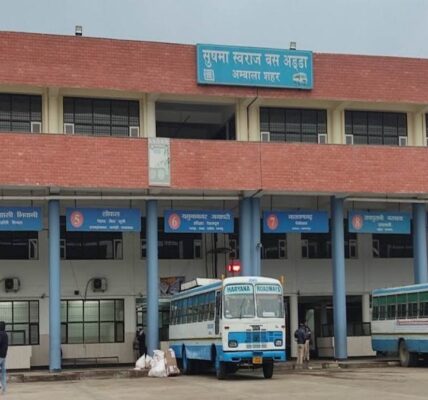The state of Haryana has significantly improved its connectivity and infrastructure in recent years. The construction of the Ambala Airport, a project that intends to provide air transport access to the northern districts of the state, is one of the most anticipated advancements. The new airport is anticipated to revolutionize the transportation system in the area because of its advantageous location in Ambala, a city renowned for its textile industry, military cantonment, and first-rate rail and road connections.
Beyond merely expanding Haryana’s aviation network, the Ambala Airport project is a step toward modern urban transportation, regional development, economic growth, and tourism enhancement.
An overview of the project
Like many other joint-use airports in India, Ambala Airport is being constructed as a civil enclave within the grounds of the Indian Air Force base in Ambala Cantonment. Through rigorous procedures and collaboration between the Ministry of Defense and the Civil Aviation Authority, this agreement permits civilian flights to operate alongside military aviation.
The airport project’s main features are the Ambala Air Force Station’s civil enclave.
spanning between 20 to 25 acres.
Basic to moderately equipped passenger terminal
Because of Air Force infrastructure, the runway is already there.
Accessibility to main thoroughfares
Flights to Chandigarh, Jaipur, Lucknow, Delhi, and other regional locations are being proposed.
In Tier 2 and Tier 3 cities, the initiative is being carried out under the Regional Connectivity Scheme (RCS)-UDAN (Ude Desh Ka Aam Naagrik), which attempts to make air travel accessible and inexpensive for regular people.
The Need for an Airport in Ambala
Despite being one of Haryana’s major cities, Ambala lacks a dedicated airport despite having good road and rail connectivity. Residents of Ambala and the nearby districts of Kurukshetra, Yamunanagar, Kaithal, and Karnal now depend on Chandigarh International Airport, which is 45–50 km away, for air travel. This leads to delays, traffic jams, and accessibility problems.
Advantages of Ambala’s Airport: Less reliance on Chandigarh Airport
Encourage investment and business trips.
Increase travel to neighboring hill stations, religious sites, and heritage sites.
Assist regional textile, agricultural, and manufacturing enterprises in expanding their market reach.
Create jobs in the transportation, hospitality, aviation, and construction industries.
Ambala is ideally situated to serve northern Haryana and portions of Punjab as a regional airport due to its strategic location between Delhi and Chandigarh.
Economic Effects and Employment Generation
It is anticipated that a working airport in Ambala will greatly strengthen the local economy. Airports often have a multiplier impact, boosting related businesses and generating both direct and indirect employment.
Potential Financial Gains: expansion in the travel, hospitality, and logistics industries
An increase in the value of nearby real estate
Construction of transportation hubs, lodging facilities, and restaurants
promotion of the import and export of electronics, textiles, and perishable items
Opportunities for young people to work in maintenance, ground crew, and airport operations
The airport will be a significant step in Ambala’s transformation into a smart, contemporary city, according to government representatives.
Location Advantage and Connectivity
The location of Ambala provides an airport with a natural advantage:
situated where NH-44 and NH-152 converge.
Rail access to Jaipur, Chandigarh, Amritsar, and Delhi
Close to places of worship and tourism, such as:
Sahib Gurudwara Panjokhra
Temple of Bhawani Amba
The mythical city of Kurukshetra
Panchkula and Morni Hills (for nature lovers)
Thus, the Ambala Airport would serve as a gateway to northern India as well as Haryana, offering easy access to both the plains and the hills.
Amenities and Facilities for Passengers
The projected civil terminal is still in the planning stages, but it should have all the necessary passenger facilities in its first phase.
Anticipated amenities include baggage belts and check-in counters.
Waiting areas and security checks
Cab and private vehicle parking
restrooms and kiosks for refreshments
Pick-up locations for taxis and public transportation
Digital ticketing and flight information systems
Potential future additions could be:
Cafes, lounges, and retail kiosks
Facilities for cargo
Support for aircraft maintenance and hangars
Obstacles and Things to Think About
Despite the project’s promise, a few issues must be resolved:
Coordination of Security
The airport must adhere to stringent security and operational protocols because it shares airspace with the Indian Air Force.
Purchasing Land
There may not be enough land close to the cantonment area for civil infrastructure.
Timeline and Budget
The success of the project depends on making sure it has enough money and is finished on schedule.
Demand for Flights
To guarantee frequent flights and successful operations, airlines must determine if operating from Ambala is commercially viable.
Effects on the Environment
Environmental and noise pollution regulations must be followed during construction and operation.
Nonetheless, other cities (such as Pune, Bagdogra, and Gwalior) have shown success with comparable concepts, which boosts trust in the Ambala Airport project.
Government Support and Involvement
The Ministry of Civil Aviation and the Government of Haryana are working together to promote the early development of Ambala Airport. To complete arrangements, senior authorities have visited the location several times and are actively coordinating with the Indian Air Force.
Government initiatives that stand out include Ambala’s inclusion in the UDAN program.
Setting aside money for terminal construction and land development
Encourage terminal management to use public-private partnerships (PPP).
Consultations with airlines and logistics companies as stakeholders
These initiatives demonstrate a great desire to have Ambala Airport up and running as soon as possible.
Prospects for the Future and Growth
Ambala Airport could eventually be able to:
becoming North Haryana’s main hub for logistics and shipping
If facilities allow, provide international charter flights.
Support pilot schools or aviation training facilities
Offer medical transport and air ambulance services.
Connect with smart city initiatives and industrial corridors
Ambala Airport has the potential to grow from a tiny civil enclave to a regional aviation center that serves the defense and civilian industries with the correct vision.
FAQs regarding Ambala Airport Q1: What is the location of Ambala Airport?
A separate terminal for civilian usage is being created inside the Indian Air Force Station in Ambala Cantonment.
Question 2: When will Ambala Airport open for business?
A: The project is currently in development; an official timeframe is anticipated shortly, and the first flights may begin in the upcoming year or two.
Q3: Which cities will Ambala Airport connect to?
A: Under the UDAN scheme, Ambala may have initial flights to Delhi, Chandigarh, Jaipur, Lucknow, and other Tier 1/2 cities.
Q4: Are there going to be flights abroad?
A: It’s a domestic regional airport at the moment. Future improvements, nevertheless, might make charter or quick international flights possible.
Q5: How will the airport serve the local community?
A: It will lessen reliance on Chandigarh and Delhi airports for travel and increase connectivity, tourism, employment, and local businesses.
In conclusion
The construction of Ambala Airport represents a significant advancement in the economic and transportation infrastructure of Haryana. It promises to increase accessibility, cut down on travel time, and create new opportunities for employment, business, and tourism by linking Ambala and the surrounding areas to the national air grid.
Ambala Airport has the potential to revolutionize Haryana’s future with the support of the government, military collaboration, and public excitement. Whether you live in the area, are an investor, or are a frequent traveler, the new airport offers exciting new possibilities.

